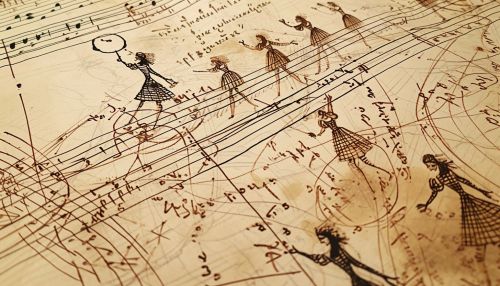Baroque dance notation
Introduction
Baroque dance notation is a system of dance notation used during the Baroque era, roughly spanning the 17th and early 18th centuries. This system, which was developed in France, allowed for the recording and reproduction of dances, a crucial aspect of the social and courtly life of the era.


Historical Context
The Baroque era was a time of great cultural and artistic development, with dance playing a significant role in both courtly and social life. The development of a system of dance notation during this period was a response to the need to record and reproduce the complex and intricate dances that were being created.
Development of Baroque Dance Notation
The development of Baroque dance notation is largely attributed to Pierre Beauchamp, a French dancer and choreographer who served as the director of the Académie Royale de Danse. Beauchamp's system, known as "Beauchamp-Feuillet notation", was first published by Raoul-Auger Feuillet in 1700 in his treatise "Chorégraphie, ou l'art de décrire la danse". This system was widely adopted and used throughout Europe during the Baroque period.
Principles of Baroque Dance Notation
Baroque dance notation is based on a system of symbols and lines that represent the steps and movements of the dance. The notation is written on a stave, similar to musical notation, with the symbols indicating the type of step and the lines indicating the direction and distance of the movement.
The system also includes symbols for the different parts of the body, such as the feet and arms, and for the various positions and movements of the body. This allows for a detailed and precise representation of the dance, including the specific steps, the timing of the movements, and the overall structure and pattern of the dance.
Usage and Impact
Baroque dance notation was widely used during the Baroque period to record and reproduce dances. This allowed for the preservation and dissemination of dances, which would otherwise have been lost. The notation system also facilitated the teaching and learning of dances, as it provided a clear and precise guide to the steps and movements of the dance.
The impact of Baroque dance notation can still be seen today, as it has influenced the development of modern dance notation systems. It also provides a valuable resource for dance historians and researchers, allowing for the reconstruction and performance of Baroque dances.
Conclusion
Baroque dance notation played a crucial role in the cultural and artistic life of the Baroque period. Its development and use allowed for the recording, reproduction, and dissemination of dances, contributing to the richness and diversity of Baroque dance. Today, it continues to provide a valuable resource for the study and performance of Baroque dance.
